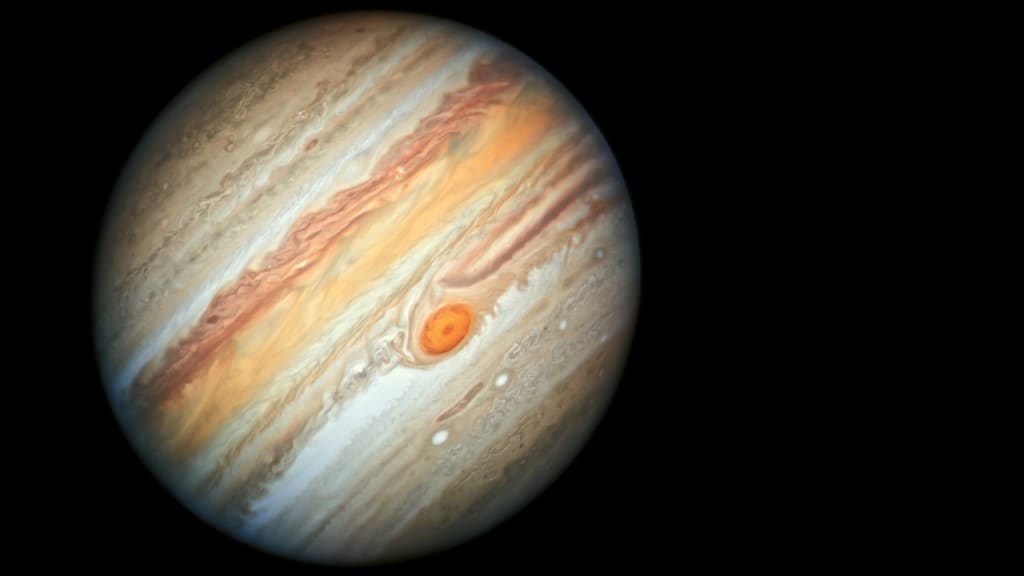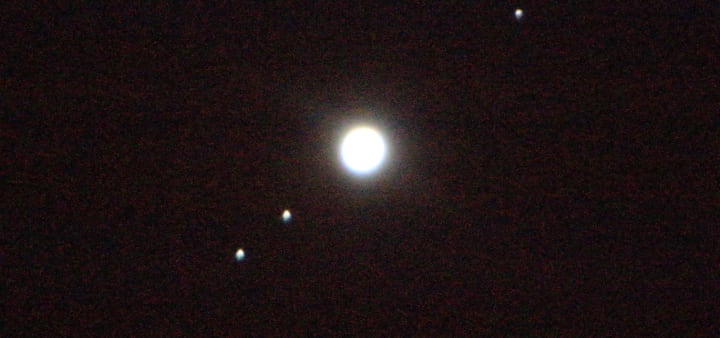That Time I Saw Jupiter's Moons Naked Eye
Their light woke me from a (not very) sound sleep

Jupiter's four largest moons are easy to see in my binoculars. They are familiar friends that I often look for when I spot Jupiter's golden light in the night sky. However, on October 24, 2012, in the wee hours of the night in Tokyo, I had an odd experience with Jupiter's moons that I still can't explain.
According to my diary:
"I was just awakened at 4:25 AM Tokyo time by a bright light shining in the window. It was Jupiter. I could see one or two of the moons. Naked eye. Through window glass. And not because it was good viewing."
To be more precise, it was Jupiter and a bright object close by. I experienced a cold chill as I tried to understand what I was seeing. One moon? No, it seemed it might be two.
A sensation of strangeness
If you don't make a habit of looking much at the night sky, you might not think there's anything odd about this observation at all. Jupiter has four moons that are large enough to be seen naked-eye from Earth. Rather, Jupiter has four moons that would be large enough to be seen naked-eye from Earth if Jupiter wasn't there.
As the fine folks from Bad Astronomy put it:
"If Jupiter were painted black, the four moons would be pretty easily seen…Shining at fifth magnitude (about twice as bright as the unaided eye can detect), they would make an eerie sight, lined up in a row. But Jupiter is there… two or three hundred times brighter than the moons, and they are swamped by its glare."
Jupiter was most definitely not painted black. Indeed, Jupiter was so bright the light shining in my window somehow woke me up.
Of course, it's far more likely the jet lag from my long flight to Tokyo woke me up. But it felt otherwise. I still recall the eerie sense the light from Jupiter and its moons had somehow called to me.
Hmm. I had a nice long skyscraper window with a view, but it wasn't as if the skies were great for stargazing. The city is famously well illuminated, and I wasn't exactly looking out over a universe of stars. Perhaps I was seeing lights from some approaching plane passing near Jupiter and --
No. I got out my binoculars and looked harder. It was two moons close together. Turning on my laptop, I pulled up Sky and Telescope's Jupiter moon finder to see which two moons they were likely to be - -Ganymede and Europa, if I read the chart right.
So I saw what I saw. Or I'm convinced I did.

But…
How is it possible? Even close together to make a single light, how could they shine bright enough to wake me from my sleep? Through window glass? In the poor night skies of a modern world city?
Most people never see any of Jupiter's moons naked-eye - not once in their entire lives. And plenty of people have better eyesight.
A puzzle
Robert Frost, an instructor and flight controller at NASA, once described an elaborate scenario where a person might catch a naked-eye glimpse of Callisto. You'd need to somehow block your view of Jupiter without obscuring that of Callisto. How? A well-placed branch? A bit of gutter hanging from a roof? That exercise is left to the reader. And even then it might not work:
"All this of course depends on the observer having excellent eyesight and the observation being done somewhere with cool, dark, and clear skies."
Also, I didn't see Callisto. I saw her big brother Ganymede who doesn't get so far away from Jupiter's obscuring light.
Ganymede is larger than Mercury, which any hobby astronomer who wants to see has seen naked-eye. Including me. And we've seen it disappear in the glare of the setting sun. So it feels possible to see Ganymede in Jupiter's glare, especially with the help of another moon. Heck, since I was there, I know it's possible because well… I saw it for myself.
Still, I can't quite explain that night or the eerie feelings surrounding my observation. Why don't more people see Ganymede or Callisto naked-eye if it's so possible? Why was I chosen to be pulled from my bed in the wee hours?
The blunt truth is this: No one doubts you can see Mercury because it's much brighter than Ganymede. It may be smaller but it's closer. By a lot.
So my questions remain: How did I see what I saw?
Was it something about the glass in my window that made it act as a telescope?
What, a telescope that only zooms in on Jupiter's moons?
A telescope that wakes me from a sound sleep to whisper, "look?"
I don't know.
It's a mystery.
If you enjoyed this story, let me know by gently tapping the <3 button. Tips are always gratefully accepted.
Photo Credits
Featured Photo: "New Hubble Space Telescope view of Jupiter" by NASA Goddard Photo and Video is licensed under CC BY 2.0
Inset Photo: "Jupiter Moons" by Saleh-Coder is licensed under CC BY 2.0 is licensed under CC BY-NC 2.0
About the Creator
Amethyst Qu
Seeker, traveler, birder, crystal collector, photographer. I sometimes visit the mysterious side of life. Author of "The Moldavite Message" and "Crystal Magick, Meditation, and Manifestation."
https://linktr.ee/amethystqu
Enjoyed the story? Support the Creator.
Subscribe for free to receive all their stories in your feed. You could also pledge your support or give them a one-off tip, letting them know you appreciate their work.






Comments
There are no comments for this story
Be the first to respond and start the conversation.